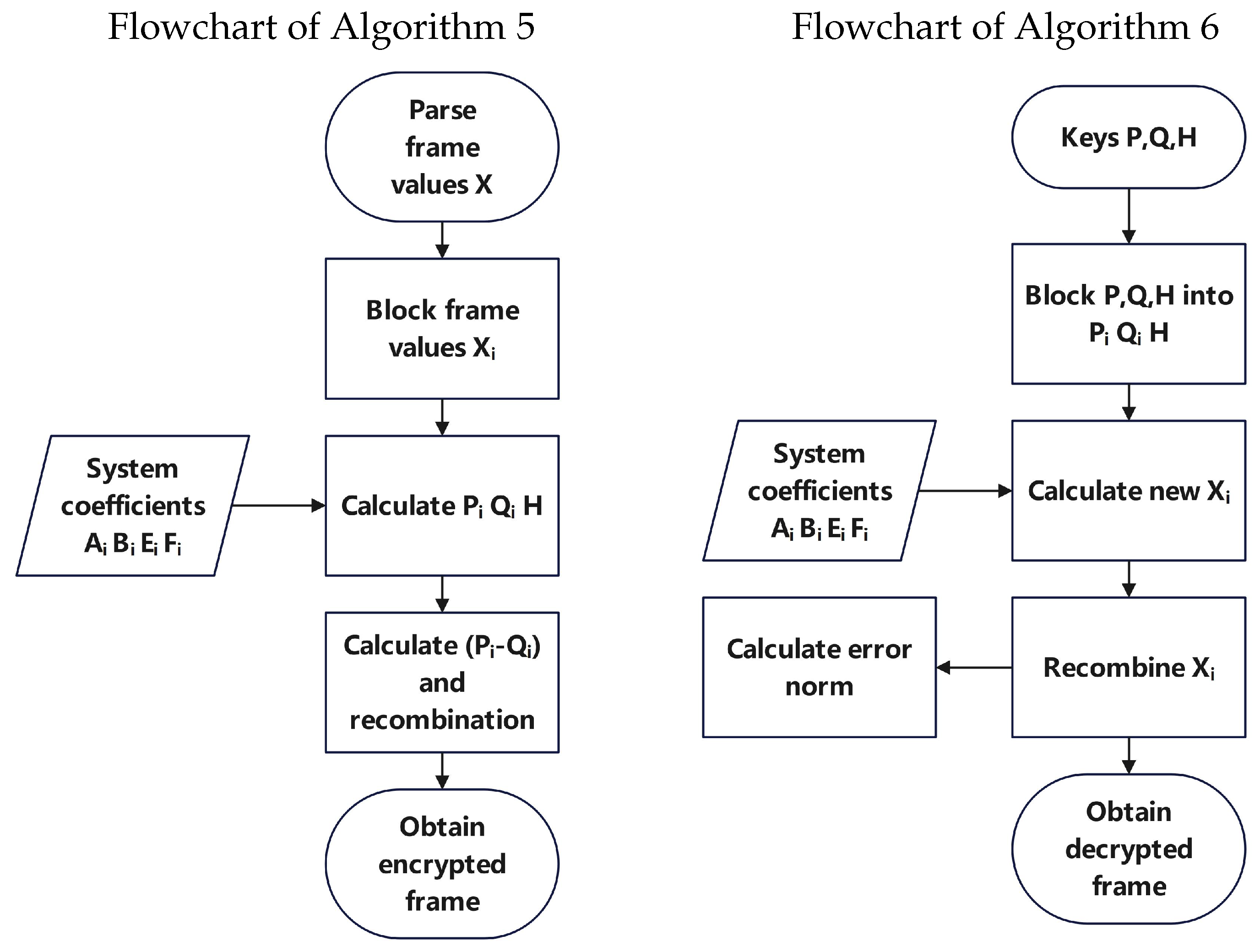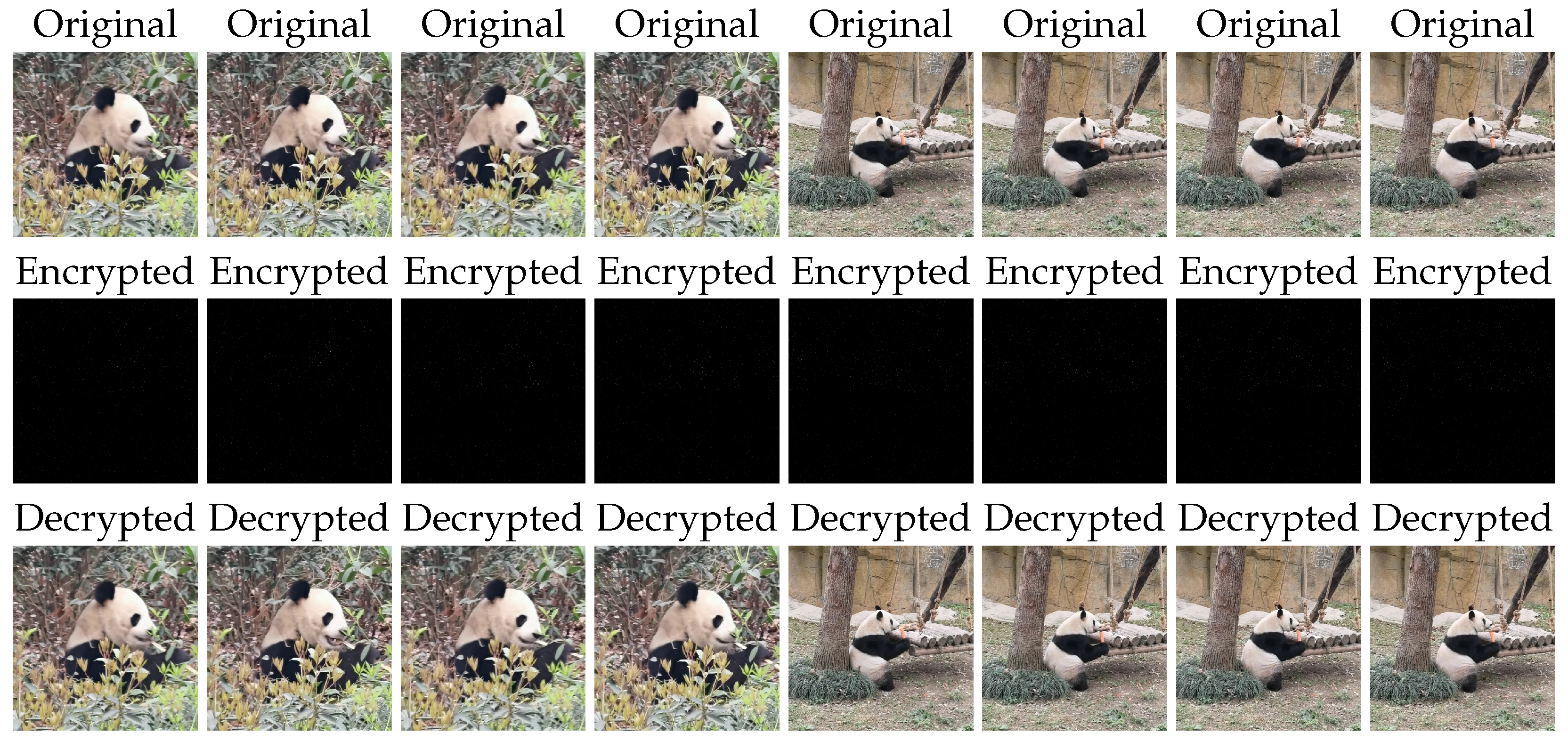The General Solution to a System of Tensor Equations over the Split Quaternion Algebra with Applications
Abstract
1. Introduction
2. Preliminaries
- (a)
- if and only if ;
- (b)
- ;
- (c)
- ;
- (d)
- .
- (a)
- if and only if ;
- (b)
- ;
- (c)
- .
3. Solution of System (1)
4. Numerical Exemplification
| Algorithm 1 General Solution of System (1) |
(1) Input the factors: n. (2) Input the tensors: and . (3) Calculate the matrices and , where . (5) If both Equation (11) and Equation (13) hold, then calculate the unique solution by Equation (14). (7) Output: . |
| Algorithm 2 General Solution of System (1) |
(1) Input the factors: n. (2) Input the tensors: and . (3) Calculate the matrices and , where . (5) If both Equation (18) and Equation (13) hold, then calculate the unique solution by Equation (21). (7) Output: . |
5. One Application Based on (1)
| Algorithm 3 Encryption Process of Videos |
(1) Input: n original videos and system coefficients and . (2) Parse the videos: represents the i-th video where and represents the j-th frame of the i-th video. (3) Calculate the tensors and by system (1). (4) Encrypt the i-th video by where . and is the key of the i-th video. (5) Output: Encrypted video. |
| Algorithm 4 Decryption Process of Videos |
(1) Input: Encrypted videos , keys and system coefficients where . (2) Calculate the numerical tensors by Algorithm 1. (3) Recover the videos: represents the i-th recovered video where and represents the j-th recovered frame of the i-th video. (4) Calculate the error norm for and . (5) Output: Decrypted video. |
| Algorithm 5 Block Encryption Process of Frame |
(1) Input: one original frame and system coefficients and . (2) Parse the frames: represents the frame and represents the i-th sub-frame of the frame where . (3) Calculate the matrices and by system (1). (4) Assemble the i-th sub-frame where back into the frame . Encrypt the frame X by . (5) Output: Encrypted frame. |
| Algorithm 6 Block Decryption Process of Frame |
(1) Input: Encrypted frame , keys and system coefficients where . (2) Calculate the matrices by Algorithm 1. (3) Recover the frame: represents the i-th recovered sub-frame where ; assemble the back into the frame . (4) Calculate the error norm between X and . (5) Output: Decrypted frame. |
6. Conclusions
Author Contributions
Funding
Data Availability Statement
Conflicts of Interest
References
- Hamilton, W.R. Lectures on Quaternions; Hodges and Smith: Dublin, Ireland, 1853. [Google Scholar]
- Took, C.C.; Mandic, D.P. Augmented second-order statistics of quaternion random signals. Signal Process. 2011, 91, 214–224. [Google Scholar] [CrossRef]
- Miao, J.; Kou, K.I. Color image recovery using low-rank quaternion matrix completion algorithm. IEEE Trans. Image Process. 2021, 31, 190–201. [Google Scholar] [CrossRef]
- Jia, Z.G.; Ling, S.T.; Zhao, M.X. Color two-dimensional principal component analysis for face recognition based on quaternion model. In Intelligent Computing Theories and Application: Proceedings of the 13th International Conference, Liverpool, UK, 7–10 August 2017; Springer: Cham, Switzerland, 2017; pp. 177–189. [Google Scholar] [CrossRef]
- Cockle, J. LII. On systems of algebra involving more than one imaginary; and on equations of the fifth degree. Lond. Edinb. Dublin Philos. Mag. J. Sci. 1849, 35, 434–437. [Google Scholar] [CrossRef]
- Adler, S.L. Quaternionic Quantum Mechanics and Quantum Fields; Oxford University Press: Cary, NC, USA, 1995. [Google Scholar]
- Shoemake, K. Animating rotation with quaternion curves. ACM SIGGRAPH Comput. Graph. 1985, 19, 245–254. [Google Scholar] [CrossRef]
- Antonelli, G.; Chiaverini, S. Fault tolerant kinematic control of platoons of autonomous vehicles. IEEE Int. Conf. Robot. Autom. 2004, 4, 3313–3318. [Google Scholar] [CrossRef]
- Krizhevsky, A.; Sutskever, I.; Hinton, G.E. Imagenet classification with deep convolutional neural networks. Commun. ACM 2017, 60, 84–90. [Google Scholar] [CrossRef]
- Carroll, S.M. Spacetime and Geometry: An Introduction to General Relativity, 2nd ed.; Cambridge University Press: Cambridge, UK, 2019. [Google Scholar]
- Griffiths, D.J.; Heald, M.A. Introduction to Electrodynamics, 4th ed.; Cambridge University Press: Cambridge, UK, 2013. [Google Scholar]
- Abadi, M.; Barham, P.; Chen, J.; Chen, Z.; Davis, A.; Dean, J.; Zheng, X. Tensorflow: A system for large-scale machine learning. In 12th USENIX Symposium on Operating Systems Design and Implementation, OSDI 16; USENIX Association: Savannah, GA, USA, 2016; pp. 265–283. [Google Scholar]
- Paszke, A.; Gross, S.; Massa, F.; Lerer, A.; Bradbury, J.; Chanan, G.; Chintala, S. Pytorch: An imperative style, high-performance deep learning library. Adv. Neural Inf. Process. Syst. 2019, 32, 8026–8037. [Google Scholar]
- Zhang, S.; Yao, L.; Sun, A.; Tay, Y. Deep learning based recommender system: A survey and new perspectives. ACM Comput. Surv. 2019, 52, 1–38. [Google Scholar] [CrossRef]
- Qi, L.Q.; Luo, Z.Y. Tensor Analysis: Spectral Theory and Special Tensors; Society for Industrial & Applied Mathematics: Philadelphia, PA, USA, 2017. [Google Scholar]
- Qi, L.Q. Tensor Eigenvalues and Their Applications; Springer Nature: Singapore, 2018. [Google Scholar]
- Ding, W.Y.; Luo, Z.Y.; Qi, L.Q. P-tensors, P0-tensors, and their applications. Linear Algebra Appl. 2018, 555, 336. [Google Scholar] [CrossRef]
- He, Z.H.; Wang, X.X.; Zhao, Y.F. Eigenvalues of quaternion tensors with applications to color video processing. J. Sci. Comput. 2023, 94, 1. [Google Scholar] [CrossRef]
- He, Z.H.; Liu, T.T.; Wang, X.X. Eigenvalues of quaternion tensors: Properties, algorithms and applications. Adv. Appl. Clifford Algebr. 2025, 35, 4. [Google Scholar] [CrossRef]
- Zhang, X.F.; Zhang, W.D.; Li, T. Tensor form of GPBiCG algorithm for solving the generalized Sylvester quaternion tensor equations. J. Franklin Inst. 2023, 360, 5929–5946. [Google Scholar] [CrossRef]
- Zhang, X.F.; Li, T.; Ou, Y.G. Iterative solutions of generalized sylvester quaternion tensor equations. Linear Multilinear Algebra 2023, 72, 1259–1278. [Google Scholar] [CrossRef]
- Gao, Z.H.; Wang, Q.W.; Xie, L.M. The (anti-)η-hermitian solution to a novel system of matrix equations over the split quaternion algebra. Math. Methods Appl. Sci. 2024, 47, 13896–13913. [Google Scholar] [CrossRef]
- Xie, M.Y.; Wang, Q.W.; Zhang, Y. The BiCG algorithm for solving the minimal frobenius norm solution of generalized sylvester tensor equation over the quaternions. Symmetry 2024, 16, 1167. [Google Scholar] [CrossRef]
- Yang, L.Q.; Wang, Q.W.; Kou, Z. A system of tensor equations over the dual split quaternion algebra with an application. Mathematics 2024, 12, 3571. [Google Scholar] [CrossRef]
- Sun, L.Z.; Zheng, B.D.; Bu, C.J.; Wei, Y.M. Moore–Penrose inverse of tensors via Einstein product. Linear Multilinear Algebra 2016, 64, 686–698. [Google Scholar] [CrossRef]
- Liu, T.T.; Yu, S.W. Some properties of reduced biquaternion tensors. Symmetry 2024, 16, 1260. [Google Scholar] [CrossRef]
- Yuan, S.F.; Wang, Q.W.; Yu, Y.B.; Tian, Y. On hermitian solutions of the split quaternion matrix equation AXB + CXD = E. Adv. Appl. Clifford Algebras 2017, 27, 3235–3252. [Google Scholar] [CrossRef]
- Ben-Israel, A.; Greville, T.N.E. Generalized Inverses: Theory and Applications; Springer Science & Business Media: New York, NY, USA, 2006. [Google Scholar]
- Magnus, J.R. L-structured matrices and linear matrix equations. Linear Multilinear Algebra 1983, 14, 67–88. [Google Scholar] [CrossRef]
- Xie, L.M.; Wang, Q.W. A system of matrix equations over the commutative quaternion ring. Filomat 2023, 37, 97–106. [Google Scholar] [CrossRef]
- Sara, U.; Akter, M.; Uddin, M.S. Image quality assessment through FSIM, SSIM, MSE and PSNR-a comparative study. J. Comput. Commun. 2019, 7, 8–18. [Google Scholar] [CrossRef]
- Feng, W.; Zhang, J.; Qin, Z.T. A secure and efficient image transmission scheme based on two chaotic maps. Complexity 2021, 2021, 1898998. [Google Scholar] [CrossRef]
- Feng, W.; Zhao, X.Y.; Zhang, J.; Qin, Z.T.; Zhang, J.K.; He, Y.G. Image encryption algorithm based on plane-level image filtering and discrete logarithmic transform. Mathematics 2022, 10, 2751. [Google Scholar] [CrossRef]
- Feng, W.; Yang, J.X.; Zhao, X.Y.; Qin, Z.T.; Zhang, J.; Zhu, Z.G.; Wen, H.P.; Qian, K. A novel multi-channel image encryption algorithm leveraging pixel reorganization and hyperchaotic maps. Mathematics 2024, 12, 3917. [Google Scholar] [CrossRef]
- Feng, W.; Zhang, J.; Chen, Y.; Qin, Z.T.; Zhang, Y.S.; Ahmad, M.; Woźniak, M. Exploiting robust quadratic polynomial hyperchaotic map and pixel fusion strategy for efficient image encryption. Expert Syst. Appl. 2024, 246, 123190. [Google Scholar] [CrossRef]
- Kong, X.X.; Yu, F.; Yao, W.; Cai, S.; Zhang, J.; Lin, H.R. Memristor-induced hyperchaos, multiscroll and extreme multistability in fractional-order HNN: Image encryption and FPGA implementation. IEEE Trans. Neural Netw. 2024, 171, 85–103. [Google Scholar] [CrossRef]
- Yu, F.; Lin, Y.; Yao, W.; Cai, S.; Lin, H.R.; Li, Y. Multiscroll hopfield neural network with extreme multistability and its application in video encryption for IIoT. IEEE Trans. Neural Netw. 2025, 182, 106904. [Google Scholar] [CrossRef] [PubMed]



| Video 1 | Error | Video 2 | Error |
|---|---|---|---|
| 1-frame | 1-frame | ||
| 10-frame | 10-frame | ||
| 16-frame | 16-frame | ||
| 25-frame | 25-frame |
| Video 1 | PSNR | SSIM | FSIM | Video 2 | PSNR | SSIM | FSIM |
|---|---|---|---|---|---|---|---|
| 1-frame | 245.4833 | 1 | 1 | 1-frame | 244.6598 | 1 | 1 |
| 10-frame | 246.1960 | 1 | 1 | 10-frame | 245.8679 | 1 | 1 |
| 16-frame | 246.0469 | 1 | 1 | 16-frame | 245.6220 | 1 | 1 |
| 25-frame | 246.0457 | 1 | 1 | 25-frame | 245.4920 | 1 | 1 |
| Video 1 | Error | Video 2 | Error |
|---|---|---|---|
| 3-frame | 3-frame | ||
| 12-frame | 12-frame | ||
| 18-frame | 18-frame | ||
| 27-frame | 27-frame |
| Video 1 | PSNR | SSIM | FSIM | Video 2 | PSNR | SSIM | FSIM |
|---|---|---|---|---|---|---|---|
| 3-frame | 245.0190 | 1 | 1 | 3-frame | 244.3713 | 1 | 1 |
| 12-frame | 244.5530 | 1 | 1 | 12-frame | 244.8359 | 1 | 1 |
| 18-frame | 244.6391 | 1 | 1 | 18-frame | 246.7069 | 1 | 1 |
| 27-frame | 245.3403 | 1 | 1 | 27-frame | 246.3910 | 1 | 1 |
Disclaimer/Publisher’s Note: The statements, opinions and data contained in all publications are solely those of the individual author(s) and contributor(s) and not of MDPI and/or the editor(s). MDPI and/or the editor(s) disclaim responsibility for any injury to people or property resulting from any ideas, methods, instructions or products referred to in the content. |
© 2025 by the authors. Licensee MDPI, Basel, Switzerland. This article is an open access article distributed under the terms and conditions of the Creative Commons Attribution (CC BY) license (https://creativecommons.org/licenses/by/4.0/).
Share and Cite
Jia, Z.-R.; Wang, Q.-W. The General Solution to a System of Tensor Equations over the Split Quaternion Algebra with Applications. Mathematics 2025, 13, 644. https://doi.org/10.3390/math13040644
Jia Z-R, Wang Q-W. The General Solution to a System of Tensor Equations over the Split Quaternion Algebra with Applications. Mathematics. 2025; 13(4):644. https://doi.org/10.3390/math13040644
Chicago/Turabian StyleJia, Zong-Ru, and Qing-Wen Wang. 2025. "The General Solution to a System of Tensor Equations over the Split Quaternion Algebra with Applications" Mathematics 13, no. 4: 644. https://doi.org/10.3390/math13040644
APA StyleJia, Z.-R., & Wang, Q.-W. (2025). The General Solution to a System of Tensor Equations over the Split Quaternion Algebra with Applications. Mathematics, 13(4), 644. https://doi.org/10.3390/math13040644







